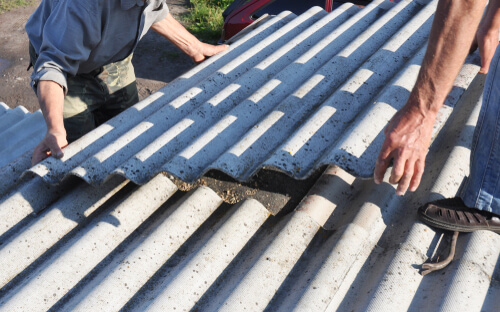Where is Asbestos Found?

Although asbestos is a naturally occurring mineral, it can be dangerous to our health when inhaled in its fiber form. This is due to the fact that when these fibers attach to the lung tissue after inhalation, they slowly work to break down lung tissue, causing irritation and scarring. This can make it difficult to breathe and can even lead to dangerous cancers, such as mesothelioma.
Many people who suffer from asbestos-related illnesses were unknowingly exposed to asbestos while at work, serving in the military, or at home. Asbestos was commonly used in the early and middle 20th century in the manufacturing of a wide range of products, including everything from insulation and piping to roofing and ceiling tiles.
Although exposure often took place decades ago, before federal regulators began requiring employers, manufacturers, and distributors to institute a number of safety rules and measures, people who now suffer the repercussions of this exposure could still be entitled to damages for their medical bills, lost wages, and pain and suffering.
For help determining whether you may have a valid claim against the company that was responsible for exposing you to asbestos, please contact the dedicated asbestos litigation attorneys at The Law Offices of Michael P. Joyce, P.C., today. The claim review is free and confidential.
Common Asbestos Exposure Sites
Many people who now suffer from the consequences of exposure to asbestos came into contact with the substance while in the workplace. Asbestos was commonly used in a number of different industries, including the mining, milling, and manufacturing industries for decades.
Because this material was used in so many different ways, employees from a wide range of backgrounds could have been exposed to high levels of asbestos, including those who:
- Worked on construction sites
- Worked in older buildings doing plumbing or electrical work
- Worked in mines
- Worked on railroads or shipyards
- Worked in textile factories
- Were engaged in asbestos abatement
Asbestos exposure does not just occur in the civilian employment. In fact, many people who are diagnosed with mesothelioma and other asbestos-related illnesses were either contracted by the military or were service members themselves at some point.
According to the U.S. Department of Veterans Affairs, this can be attributed to the inadvertent exposure to toxic chemicals when buildings containing this mineral were damaged or destroyed during wartime. Other individuals, however, came into contact with asbestos while working in certain jobs, such as:
- Vehicle repair
- Mining
- Milling
- Construction
- Carpentry
- Demolition
Active-duty service members who were required to work with particular products are encouraged to seek medical attention, as they may have been exposed to asbestos. These products include everything from pipes and insulation to roofing and flooring.
Asbestos was also used in a number of different consumer products for decades before the link between exposure to this mineral and certain deadly cancers was identified. These products were often used in the construction of homes in the 1940s and 1950s. Thousands of people were unknowingly exposed to this dangerous fiber while going about their day-to-day lives.
Common Products Containing Asbestos
Because of its heat resistance and fiber strength, asbestos was used in the manufacturing of thousands of consumer products. According to the Environmental Protection Agency (EPA), many of these products, including the following, were used in the construction of both commercial and residential buildings:
- Insulation, which was often manufactured with asbestos fibers due to its heat resistance and ability to slow the transfer of heat, all of which made the material uniquely equipped to contain heat in the home
- Piping, which was often manufactured using asbestos fibers, as this material worked as an insulator, while adding tensile strength to the pipes themselves
- Ceiling tiles, which were typically used as ceiling inserts to hide duct work in warehouses, office buildings, schools, and hospitals, and were often made partly from fire-resistant asbestos fibers
- Floor tiles, which were often manufactured using asbestos fibers in an effort to make the flooring stronger and more fire resistant
- Textured paint and plaster, in which asbestos was added in the form of a wet mixture in order to increase the tensile strength of the product and improve its holding power
- Patching compounds, which are substances similar to plaster in texture that are used to seal the joints between sheets of drywall or to repair drywall damage, and was often made using asbestos materials, which decreased the flammability of the product
- Roofing shingles, which were manufactured from a mixture of fibers and cement in an effort to make the materials more rigid and durable and less prone to rot and water damage
- Siding, which was made with a combination of cement and asbestos before being pressed into siding shingles and were known for being durable, fire-resistant, and absorbing paint well
- Cement products, which were often strengthened using asbestos fibers, as these additives were known for increasing strength, while still being lightweight
- Electrical components, such as electrical panels, which receive and distribute electricity for a building and when combined with asbestos, could help reduce the risk of fire and electrocution
- Boilers, in which water is heated and then transferred for use in a number of applications, including water heating, cooking, and central heating and were often manufactured with asbestos fibers, as this substance could insulate the boiler and keep the heat from dissipating, while also keeping gaskets and sealants from overheating
The use of asbestos was not limited only to building materials. In fact, the Occupational Safety and Health Administration (OSHA) warns consumers that asbestos can often still be found in the following products:
- High friction products, such as vehicle clutches, brakes, and transmission parts, all of which are specifically designed to help vehicles run smoothly without overheating due to friction or overuse
- Gaskets, which are used to create a tight seal between pieces of machinery or pipes and are often used in engines and heavy industry
- Generators, which convert mechanical energy obtained from external sources into electrical energy and often came with an asbestos lining that was used to prevent explosions
- Turbines, which are engines that extract energy from fluid or air and then use that energy to power buildings and machinery and were often produced with asbestos, as this mineral helped shield the turbine from the heat generated during this process
- Pumps, which are machines that are used to move fluids, such as water, steam, oil, or chemicals and are often equipped with gaskets and packing materials made of asbestos
If you were exposed to asbestos while manufacturing, installing, or using one or more of these products and have developed an asbestos-related disease, you could be entitled to damages compensating you for your medical bills and related costs. Please call one of our dedicated attorneys today to learn more about your legal options.
What to Do If You’ve Been Diagnosed with an Asbestos Disease
If you were recently diagnosed with an asbestos-related disease, such as mesothelioma, you should immediately begin planning a treatment regimen, which could include surgery, radiation, chemotherapy, or a combination of these treatments.
Once you have obtained medical assistance, you may want to consider speaking with an experienced asbestos litigation lawyer who can help you seek compensation for your losses from the at-fault employer or company responsible for your exposure to asbestos.
While this process could involve filing a lawsuit, this is often not necessary. Many companies that went bankrupt years ago after coming under fire for their use of asbestos were forced to create trust funds from which eligible parties could collect funds if later diagnosed with mesothelioma or another asbestos disease.
In addition to these options, employees or former employees of companies that exposed their workers to dangerous levels of asbestos could be required to make regular workers’ compensation benefit payments. However, it’s important to note that although these benefits cover healthcare costs and wage loss, they do not compensate for pain and suffering.
To obtain compensation for pain and suffering and emotional distress, the injured party will likely need to file a claim against the employer in court. It is not uncommon in these situations for the employer to offer a settlement to the plaintiff in order to avoid hefty court costs.
Ultimately, which route a person chooses to take when seeking financial assistance after an asbestos disease diagnosis depends on the specific circumstances. This makes it especially important for individuals who have been affected by asbestos exposure to speak with an attorney before proceeding with a claim.
Talk to an Asbestos Litigation Lawyer Now
To speak with an experienced asbestos litigation lawyer about pursuing compensation for your asbestos-related medical condition, please contact The Law Offices of Michael P. Joyce, P.C., today. A member of our legal team is standing by to begin working on your case.

